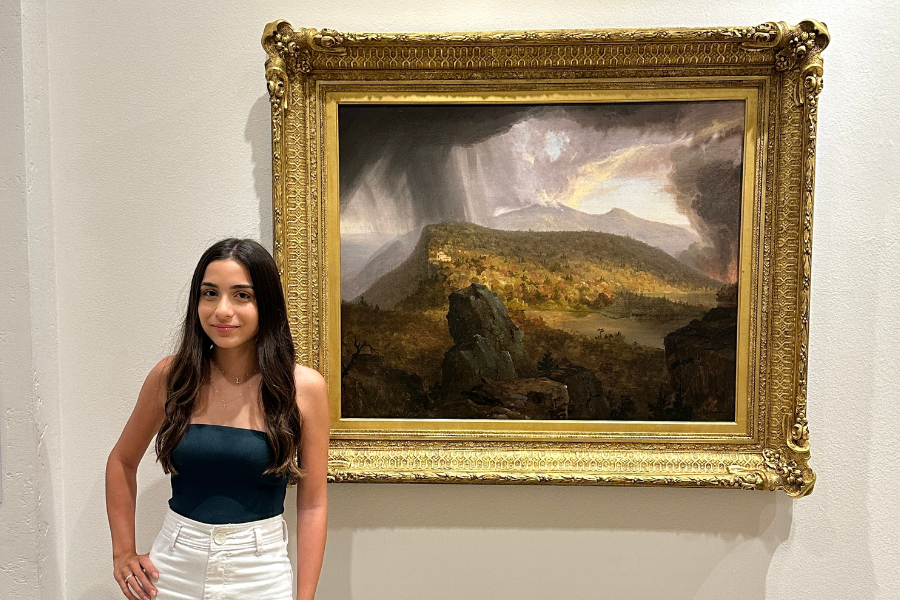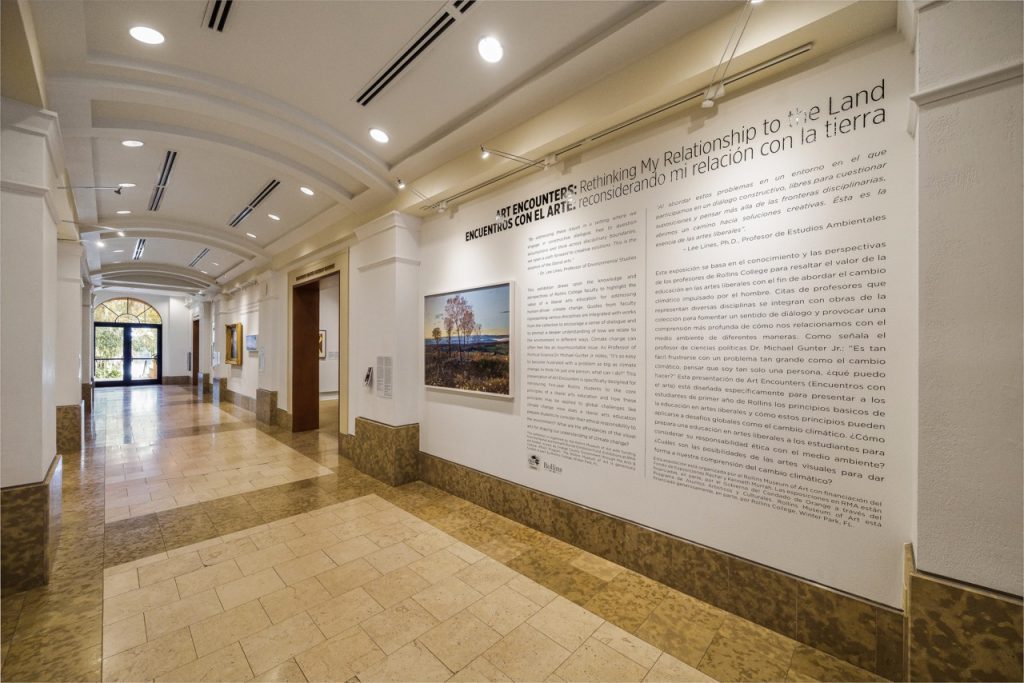by Lavinia Franco De Mello Audi Goncalves ’27

As a teaching museum, Rollins Museum of Art often serves as a classroom, a creative space where students engage with artworks, drawing connections to their curriculum. When Rollins College professor Dr. Anne M. Stone brought her rFLA 100: Introduction to Global Challenges and Solutions students to RMA, student Lavinia Franco De Mello Audi Goncalves ’27 found herself drawn to Thomas Cole’s Catskill Mountain House, The Four Elements which she shares in her reflection below. Dr. Stone explains:
“Throughout this course we explored global challenges and solutions through multiple perspectives, including social and environmental lenses. We also discussed how different disciplines think about knowledge in different ways and developed skills in information literacy to critically analyze information.”
Visiting Art Encounters: Rethinking My Relationship to the Land
During my visit to the Art Encounters: Rethinking My Relationship to the Land exhibition, in Winter 2025, one artwork that stood out to me was Catskill Mountain House, The Four Elements (1843–44) by Thomas Cole. This painting shows a dramatic natural landscape with mountains, storms, and fire. In the background, there’s a building that, as I learned from the museum guide, represents a hotel. This detail made me reflect on how humans try to claim and control nature, yet it remains vastly greater and more powerful than us.
What impacted me most were the rocks in the foreground, which seem to block our path, almost as if nature itself is telling us we’re not allowed to enter. It made me feel disconnected, as though there’s a boundary between us and the natural world that we’ve created through exploitation. The dark colors, the fire on the right, and the storm clouds together create a sense of urgency, destruction, and warning, visually expressing the consequences of human impact on the environment. It’s truly impressive how a painting created so long ago can still carry such deep meaning and insight, remaining incredibly relevant to today’s global environmental challenges.
Communicating Critical Global Issues Through Art
This painting challenged me to rethink how art communicates critical global issues like climate change and sustainability. The exhibit as a whole brings together multiple ways of knowing, artistic expression, scientific insight, and cultural narratives. One example is the work of Dr. Michael Gunter Jr., Professor of Political Science, who emphasizes the value of direct experience in nature to inspire grassroots climate activism and ease “eco-anxiety.” As he writes, “Direct experience is a powerful educational tool. It helps us better understand not only places further afield but also the homes from which we come.” This quote connects deeply with Cole’s vision, showing that even centuries apart, the emotional and moral power of nature can drive awareness and transformation.
This variety of perspectives—scientific, artistic, and even emotional—contrasts with how we usually approach global challenges, focusing mostly on data and policy. Art, in this case, invites us to feel and imagine in ways that academic papers sometimes cannot. It gives form to our fear, grief, and also hope.
Something the museum guide said also stayed with me:
7 out of 10 Americans know they need to change their behavior to address climate change, but they don’t know how. It’s not just a lack of knowledge, it’s a lack of direction.
Exhibits like this one can help build not only awareness, but empathy and emotional understanding.
Art as Knowledge Production
This exhibit expanded my understanding of information literacy by showing that knowledge is not limited to books, articles, or data, it can also be visual, emotional, and symbolic. Art functions as a powerful form of knowledge production because it communicates complex ideas in ways that engage both the intellect and the emotions. It can reveal environmental issues through metaphor, provoke empathy through imagery, and challenge dominant narratives by offering alternative perspectives. Unlike traditional academic sources, which rely on logic, evidence, and structured argument, art often speaks through feeling and interpretation.
Overall, this exhibit reshaped how I think about my relationship with the land. It reminded me that addressing global challenges like climate change requires more than science or policy, it demands honesty, ethical responsibility, and a deeper connection to the natural world. It made me realize that part of the solution lies in rebuilding our sense of respect, humility, and responsibility toward the land we live on.

